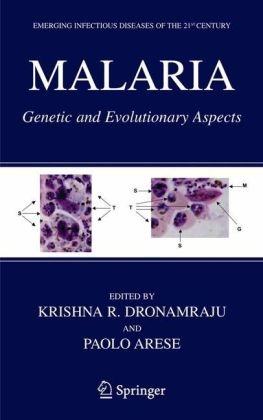Read more
This book is an edited collection of papers by leading experts on the population genetics and evolutionary biology of malaria, a disease which results in three million deaths each year in the world. "Malaria Hypothesis" refers to the hypothesis, which was proposed by J.B.S. Haldane at the 8th International Congress of Genetics in Stockholm in 1948, that the identical geographic distribution of both falciparum malaria and thalassemia in the mediterranean region suggests that the heterozygous individuals for thalassemia (or microcythemia as it was called then) might have greater resistance to malarial infection. Haldane, later in the same year, expanded his theory to infectious disease in general at another international conference, at Pallanza in Italy. Haldane's hypothesis was subsequently confirmed in the African populations by A.C. Allison and later by others during the last fifty years, although at first for sickle cell anemia and later for thalassemia with varying degrees of success. The malaria hypothesis still remains today a unique example of that kind of balanced polymorphism, not only in genetics but in all of biology. It opened up new insights into our perspective of the genetics and population dynamics of disease prevalence, particularly infectious disease.
List of contents
Preface.- Introduction. Malaria: Genetic and Evolutionary aspects.- J.B.S. Haldane (1892-1964).- Removal of Early parasite forms from circulation as a mechanism of resistance against malaria in widespread redblood cell mutations.- Clinical, epidemiological and genetic investigations of thalassemia and malaria in Italy.- Resistance to antimalarial drugs: Parasite and Host Genetic factors.- Evolutionary origins of human malaria parasites.- Vector Genetics in Malaria Control.- The rate of mutation of human genes.- Disease and evolution.
Summary
This book was originally conceived at a conference at the University of Turin in Italy. The conference was organized to examine the so-called “Malaria Hypothesis”, that is to say, the higher fitness of t- lassemia heterozygotes in a malarial environment, and to pay tribute to the proponent of that hypothesis, J.B.S. Haldane. Contributors to this book examine certain genetic and evolutionary aspects of malaria which is a major killer of human populations, especially in Africa and Asia. There were attempts to discredit Haldane’s contribution from two directions: (a) it has been suggested that the “Malaria Hypothesis” was known long before Haldane and that there was nothing original about his idea (Lederberg 1999), and that (b) the hypothesis of heterozygote su- riority was first suggested by the Italian biologist Giuseppe Montalenti who communicated his idea to Haldane (Allison 2004). Surely, both c- not be right. In fact, the evidence presented in this book clearly indicates that both are wrong. Haldane’s malaria hypothesis has stimulated a great deal of research on the genetic, evolutionary and epidemiological aspects of malaria d- ing the last 50 years. It has opened up a whole new chapter in the study of infectious diseases. It deserves serious consideration. For helpful discussions we thank Lucio Luzzatto, Alberto Piazza, Guido Modiano and David Roberts.
Additional text
From the reviews:
"Malaria focuses on genetic and evolutionary insights into a paradise blamed for the death of a child every 30 s worldwide. … Malaria: Genetic and Evolutionary Aspects will benefit a broad range of medical, scientific, and public health professionals. Besides strengthening our understanding of the evolutionary origins of malaria, the text opens new perspectives into infectious diseases." (Richard A. Stein, American Journal of Physical Anthropology, Vol. 133, 2007)

